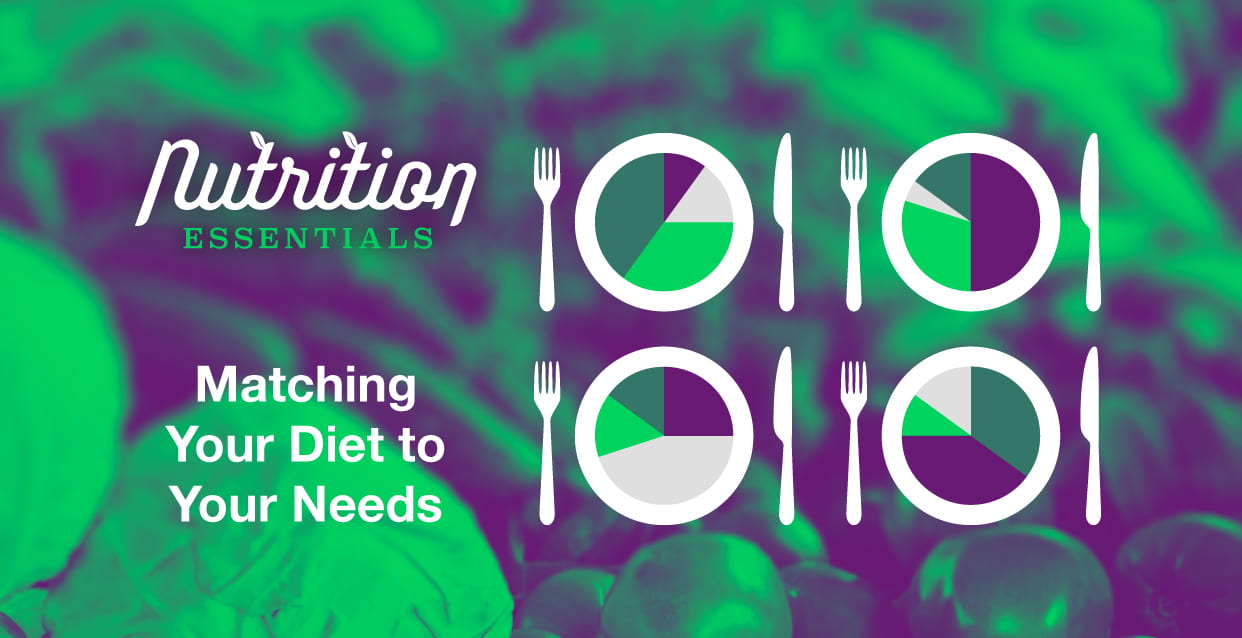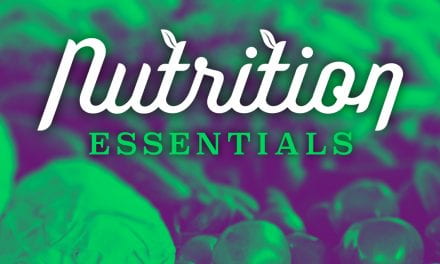In the first article, we talked about what makes up our diet, breaking down the different macronutrients, skimmed over minerals and vitamins, then went into a little deeper dive about the caloric density of foods and how that can have an impact on your food choices. We followed this up with understanding the nutrition labels on foods, both from the technical breakdown on the back of the labels to the potential marketing aspects often seen on the front of the packaging. Taking the previous information, we want to synthesize it into a helpful tool to achieve our goals best.
Recommended Intake Ranges
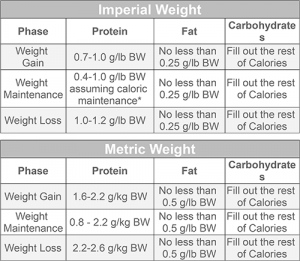
These numbers for recommendations for weight loss and weight gain are found in several lines of research. However, weight maintenance is typically not a desirable outcome for researchers. Therefore, it is an extrapolation of the research combined with my understanding and using client and personal data to give some recommendations.
This chart can seem rather pointless when you search for precise answers. Instead, I want to draw your attention to the extreme flexibility that these charts indicate. We can do everything from the extreme of a ketogenic diet, on the extreme of high-fat low-carb, all the way to high-carb, low-fat diets, and anywhere in between to achieve body composition changes. We want to ensure that we are hitting our protein requirements based upon our desired results.
How Many Calories Do I Need?
Our caloric needs break down into the following parts:
- TDEE = {BMR + NEAT + Exercise + TEF}
- TDEE: Total Daily Energy Expenditure
- How many calories we expend daily.
- BMR: Basal metabolic rate
- The amount of energy our body needs to maintain its current size.
- NEAT: Non-Exercise Adaptive Thermogenesis
- NEAT consists of all the little things we do throughout the day, like twiddling our thumbs and pacing.
- TEF: Thermic Effect of Food
- The amount of energy that is required to break down and use the food we consume.
- TE: Thermic Effect
- TE fat: ~0-3%
- TE Carbs: ~5-10%
- *Fiber has similar effects to protein
- TE Protein: ~20-30%
- Exercise: Activity to do the activity
Quick and Dirty – A Less Accurate Way
TDEE is the number of calories that we use daily or the “Calories Out” side of our caloric equation. The most significant impacts to TDEE for individuals are our BMR and our NEAT, with exercise sometimes creeping into contention. In theory, we could exercise more. In practice, however, this tends to lead to an increase in hunger, and our body tends to defend our current weight when we add the additional stress of exercise into the equation.
Bodyweight in pounds x 10 = Basal Metabolic Rate
Bodyweight weight in kilograms x 22 = Basal Metabolic Rate (BMR)
There are more accurate ways to predict, like the Harris-Benedict equation, but a significant error can make the extra effort in these calculations pointless.
NEAT can be a bit tricky to estimate but again, how about we keep it simple and follow along with a chart that researchers follow:
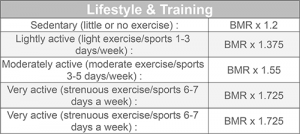
If you are unsure of your current activity level, choose the most forgiving one for your goal. If that is weight gain, assuming more training. If it is weight loss, think less. This activity multiplier calculation will take into account your exercise as well, so no need to make any additional calculations for that.
As for TEF, this ends up being a minuscule amount of calories and should not be worried about unless you are going into bodybuilding or similar physique-based endeavors. To give an example of this insignificance:
- We assumed that 30% of a person’s caloric intake is protein, and 30% is lost due to TEF.
- The increased number of calories would be .30*.30= 0.09 or 9% change if you made this a perfect caloric swap for fat, which had the lowest TEF.
- For every 1000 calories of fat you replace with protein, you would burn 90 extra calories.
Example Calculation:
- Male
- 86 kg 190 lbs
- Moderately active
- BMR = 190*10 = 1760
- TDEE = 1900 * 1.55 = 2945 Calories per day
Now, for those of you who are saying to yourselves, “Hey, that doesn’t account for age or sex,” you are correct; remember, this is a quick and dirty version to get you started on the right foot.
Creating Your Specific Plan
We are going to go with a technical approach here. There are other ways you can create these adjustments by swapping out foods, limiting meal times that don’t include explicitly counting calories, but they end up making caloric adjustments all the same. I like technology, so I tend to track everything on my phone using apps. My two favorites are myfitnesspal and nutritionix, be aware that MFP is user-generated and has a few mistakes. Input into these apps what you are eating, or do the calculations yourself for two weeks and your weight. Your weight should be taken in the same state of dress, minimal, at the same time of day, ideally morning, and after more eliminations. Once you have your two weeks of data, 10/14 days minimum for accuracy, we can start to have a little fun and customize your caloric needs.
The above example of a 190 lb male who is moderately active tracks their caloric intake and weight for two weeks has the following results (see below for chart):
- Week 1: Average Calories 2300 Average weight 189.4
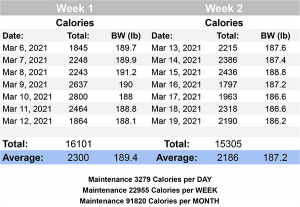 Week 2: Average Calories 2186, Average weight 187.2
Week 2: Average Calories 2186, Average weight 187.2
We know that there are approximately 3500 calories in 1 pound of fat.
- Take our week two average weight (187.2) – week one average weight (189.4) = -2.2 lbs.
- -2.2 lbs mean there is a difference of approximately -7650 calories over seven days
- Take -7650/7 = -1093 Calories per day
- Take the difference from week 2’s average and calories per day from fat
- 2186-(1093) = 3279 maintenance calories
- Note: Fat is approximately 87% fat 13% water if you want to get specific but not necessary for most.
- 2186-(1093) = 3279 maintenance calories
Using a two-week average, we can get our actual maintenance caloric requirements, which can differ significantly from our predictions, 2,945 vs. 3,279. By understanding our maintenance caloric requirements, we can begin to make adjustments to our diet accordingly.
Adjusting Weight
Caloric Requirements
Typically, if we try to gain lean mass, we want to target a caloric surplus that would have us gaining 0.5%-1.5% of our bodyweight per month.
- Using our above example, that would be 190*0.005 = .95 lbs/month to 190*0.015 = 2.85 lbs/month.
- For the simplicity of the example, we are going to target a 1 lb/month surplus. Remember 1 lb of fat is 3500 calories
- Let us keep it simple and say there are 30 days in a month
- 3500/30 = Approximately 117 calories over maintenance
- Maintenance + change in calories = target: 3279+117 = 3396 calories per day
I would recommend this person sets their caloric intake between 3300 and 3800 calories per day to maximize their anabolic potential.
Protein Requirements
Protein has the most significant impact on body composition. Ensuring you have enough, especially in a weight loss phase, can be the difference between successful long-term weight management and yo-yo dieting.
Continuing with the same client example using the protein recommendations for weight gain:
- 190 lbs we have a range of 0.7-1.0 g/lb bodyweight
- 7*190 = 133 g/protein to 1*190 = 190 g/protein
- Remember 4 Cal per 1 gram of protein:
- 133*4 = 532 Calories from protein
- 190*4 = 760 Calories from protein
Fat Requirements
Fats are a bit tricky. We never want to go below our .25 g/lb bodyweight. On the other hand, going too low with fat intake can have disruptive effects on our hormones; this is especially important for females as hormonal disruption tends to impact females’ health significantly. Generally, we want to focus on getting 15-25% of our diet from fats. Ideally, we limit saturated fats to less than 5% of our caloric intake and focus on unsaturated fats.
For our current client example:
- 190 lb male with a caloric goal of 3300 Calories
- Remember 9 Calories per gram of fat
- 15*3300 = 495 calories from fat 495/9 = 55 grams of fat
- 25*3300 = 825 Calories from fat 825/90 = 91 grams of fat
- Check our minimum .25*190 = 47.5 grams of fat
Now that we have this information, we can triangulate some of our targets. If we strive at the top end of our protein range, this will be 760 calories. If we decide that we like having fat in our diet, let us take the 825 Calories for that, and we have 1585 total calories. Cool, now we are cooking and with one final category left.
Carbohydrate Requirements
Carbohydrates are not technically required by the body to survive like fats and proteins, but they improve things. They are the most accessible source of quick energy for our body and help replenish glycogen in our muscles to work at higher intensities. Carbohydrates are the primary fuel source for our brains, which is why some individuals who go on low carbohydrate diets will get brain fog and have trouble focusing. Suppose we maintain a low-carb diet for an extended period. In that case, our bodies begin to become more efficient at utilizing ketone bodies, typically an emergency fuel source for the brain, as a primary fuel source.
For our current client, we have plenty of room in his diet for carbohydrates
- 3300-1585 = 1715 calories available for carbohydrates
- Remember 4 Calories per gram of carbohydrates
- 1715/4 = 428 grams of carbohydrates
What kind of carbohydrates this person should consume depends on how easily they digest fibrous foods. Once, they had 6-10 servings of fruits and vegetables to ensure they have lots of vitamins and minerals in their diet. They may need to add some extra with sweets, dried fruits, or maybe going back and bumping up their fat intake.
Additional Notes on Caloric Adjustments
When making dietary adjustments, we want to take into account some of the body’s natural defenses. Our bodies tend to defend a given setpoint, meaning every individual will have a natural level of fat that our body will prefer to stay above or not exceed. Knowing about this setpoint can help explain why our weight change is not consistent and that we may hit plateaus from time to time.
A few critical notes about weight loss, weird things begin to happen when we try to push our weight loss phase for too long. First, target no more than a 10% body weight loss for any weight loss phase. Second, after achieving that aggressive weight loss goal, take an equal duration of time to maintain your weight, within 5% of your weight loss target, before attempting another weight loss phase. When estimating your weight loss goals stick between 0.5% and 1.0% body weight loss per week to preserve lean mass and reduce fatigue. Finally, “Don’t Panic!!” if you have a week where you did everything correctly and your weight didn’t budge, take a deep breath and look to see if there is a trend in the direction you want. Hold steady with your diet for an additional week before making any changes; it might just be one of those random hiccups in the trend.
Quick Swaps Depending upon Your Goals
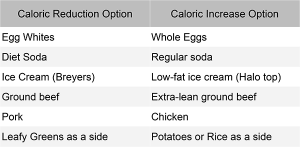
Do I Really Need to Count Calories?
You do not need to count calories to achieve your goals, and it is just a way to demonstrate how all dietary interventions work. For example, suppose we implement something like a ketogenic diet. In a ketogenic diet, the body composition changes come because it may make you feel fuller, increase protein intake and limit how many calories you consume if you tend to overeat on high sugar foods. If you struggle with evening snacking, then a strategy like intermittent fasting may work best for you, as it will limit your intake during the times you have the most significant struggles. If you don’t want to track and are better at creating rules around when to eat or what to eat, these are very viable options for success, but they still lead to the same outcome of energy balance.
Add Flexibility to your Diet
When most individuals think about their dietary adjustments, they will think about their caloric balance through a daily lens. By expanding the amount of time, we have to achieve our nutritional goals, and we can open up several new options and still reach our desired endpoint. For example, if we think about a weight loss goal and our maintenance calories are 2500 and want to cut them down by 20% to 2000 on average, we could do each day at 2000 calories to get 14000 a week, or we could have two re-feed days at 2250 and knock the rest of the days down to 1900 and still achieve our 14000 calories a week. There are many different ways to make these adjustments, and if you really think you are going to struggle on one day, let us say a holiday, then you may want to cut out some calories or 2, 3, or even upwards of a month to make that holiday feast fit better with your goals.
If you want to get fancy with your diet, you can look into options such as diet breaks, re-feeds, or other strategies that work for people. Some research suggests that a diet break like eating at maintenance for a week after four weeks of caloric deficit may help preserve metabolism, but this is preliminary research. There is a robust debate on this point.
Increasing Your Chances of Success
Our bodies try to maintain a level of balance called homeostasis. Our body’s preference is to make minor adjustments to the system to fend off weight changes to support this balance. Generally, in North American culture and society, there is plenty of hyper-palatable food that we can consume at most times of the day, making weight gain less of a concern. We want to focus on two issues when trying to add additional muscle mass in a caloric surplus. First, make sure we are getting enough protein and spread it throughout the day. Most North American diets tend to get more than enough protein daily to support muscle growth. However, suppose you are vegetarian, vegan, or have other dietary restrictions. In that case, you should assess your protein intake, and you may need to supplement with some additional protein to improve lean mass gain. Second, we want to ensure we are getting high-nutrient foods like fruits and vegetables into our diet in addition to getting adequate protein. Some individuals, when dieting, will avoid higher fiber foods due to the increased fullness they feel, but these foods contain many health-promoting compounds and should not be neglected.
Work Within Your strengths
A few approaches you can take for weight loss may make your weight loss journey more palatable. First, find out whether you prefer flexibility or rigidity in your goals. If you are an individual who desires to have set rules, you will likely succeed by adding in some restrictions like intermittent fasting or no foods after a particular time. Individuals who prefer more rules may plan for structured re-feeds and prefer to stick with a few go-to food sources. Those who enjoy more flexibility may choose strategies that focus on calorie counting, giving them the flexibility to eat with more variety and at various times but focus on hitting a protein and calorie goal. Next, make sure your approach fits your personality. Make it as easy as possible to stick to your goals; you don’t need to suffer to show how tough you are. We talked about strategies to increase your adherence.
Sleep
Now let us discuss how to manage hunger and make it easier to hit your caloric goals. A massive issue for many people is getting high-quality sleep. If we have a night of poor sleep, it will affect the rest of our day, but if we get enough sleep the following day, there probably has not been much damage done. If we have struggled with sleep for days, weeks, months, or even years, this can lead to massive dysregulation of hormonal signals in the body. Dysfunction of hormonal signals can increase your hunger, especially for high-caloric density foods, decrease satisfaction with eating those foods and increase forgetfulness. So creating a sleep routine can be a great way to manage this. Some research suggests a higher protein snack before bed may help with sleep, but the results may vary for you. Limiting the number of meals that are ad-hoc or just thrown together can increase the consistency of caloric intake and minimize those random trips to pick up a quick snack at the coffee shop or fast food place and ensure proper protein intake. Many individuals have some step counter now get out and put that thing to work. For example, when we walk, we do not tend to eat, which makes things easier.
Exercise
Regular walking seems to help regulate our hunger signals, making it easier to know when we are full. From my own experience with both myself and clients, I have found that moderate to high-intensity cardiovascular exercise tends to stimulate significant cravings for high caloric-density foods. Individuals who focus on doing more moderate-high intensity exercise frequently struggle with overshooting the additional caloric requirements of the cardiovascular exercise. Strength training seems to have a similar impact on hunger to low-intensity cardiovascular exercise such as walking. Some recent research into the “gravit-o-stat” hypothesis breaks down to “Our body knows our weight. If we add additional weight, then our body will send a reduced number of signals for caloric consumption to maintain homeostatic balance.” The “gravit-o-stat” hypothesis could give a small window into why strength training seems beneficial for weight management.
Hydration
Another way we can improve the likelihood of success is to ensure we are staying hydrated. Making sure to drink enough water fills up our stomach to increase fullness and helps our bodies complete the necessary processes for energy production and use. Dehydration can lead to overconsumption of food, giving some credence to the idea that lower-intensity cardio and strength training may not have the same overeating effect as moderate-high cardiovascular training since they do not typically end up in dehydration.
Food Choices
Food choices seem like an obvious way to manage your hunger, focusing on high protein lean meats. If you do not eat meat, most protein sources are lean. Incorporating more lean protein sources into your diet increases your feeling of fullness. In addition, protein gives you a little nudge with the thermic effect of food while aiding in the muscle-building and recovery process. A little hack is to add cooked mushrooms into meat dishes. Mushrooms have very few calories lots of nutrients and will tend to cook to a similar to meat; this gives you move volume and lowers the caloric density of meals. Next, focus on consuming various vegetables; leafy greens can be a great source of nitrates that can help with cardiovascular health, contain lots of fiber and take you a while to eat. Beans and Legumes may be partial proteins but still include significant amounts of protein and fiber; lentil soups or bean salads can be great low-calorie options.
Your Mindset
Framing your mindset around body composition changes can be a challenge. For those looking to gain muscle, you may have to get comfortable with the feeling of being a little “fluffy.” Focusing on the long-term potential and understanding that there is a reason for your current physique can go a long way to reducing anxiety around weight gain. If you prefer to stay leaner while gaining muscle, there is nothing wrong with that, and you have a few options. The most obvious is to keep your caloric surplus to a minimum. Remember that 0.5% body weight gain per month. Another approach is to implement mini-cuts every 3-6 months. Just note you want your build phase to be at least three times as long as your mini-cut, or else you’ll just be spinning your tires. Some individuals have a problem with framing their weight gain as “I’m just getting fat” or “I’m losing my abs.” Instead, think about your weight gain like this “I’m giving my body the energy it needs to get stronger” or “I’m Fueling my muscle-building potential.” Setting yourself up in a positive mindset to be comfortable with feeling strong is crucial in the long-term development of strength and size.
Tracking
If you plan to try and achieve weight loss at a standard rate and do not expect to compete in any events where body composition changes are needed, take it easy. It can be gratifying to see changes over time. Ensure to track your progress so one or two “unsuccessful” weigh-ins don’t have an outsized impact on your general accomplishments. Focus on adding in foods and habits that will aid you in your journey. Think, “I’m going to go for a walk and get some fresh air” instead of “I have to go for a walk, and I’m missing my Netflix show.” Instead of saying, “I can’t have that cake,” adjust and frame, “I’m going to have those strawberries.”
Our mindset can have a considerable impact on the likelihood of our success, so try to set yourself up for success by adding some simple mindset hacks.
Conclusion
Making long-term sustainable changes to your diet can be challenging. However, building up a robust support system that encourages healthier food choices, creates small positive habits, and encourages an active lifestyle can make your short-term weight changes into long-term sustainable results. Now that you have the tools, you can go out and create your meal plans, make adjustments to your daily activities, and surround yourself with individuals who share your desires and goals.
Check out the first article in this series
Understanding Nutrition Labels
Visit our website for information on training consultations, virtual coaching, plus individual and group personal training. If you’re ready to work with one of our Exercise Specialists, fill out the consultation form so we can connect you with the best trainer to help you meet your goals. Sign-up to receive our monthly newsletter for news, announcements, program information, swim tips, and exercise demos.
by Kyle Babiuk
Kyle is a Bachelor of Kinesiology Graduate and is certified with the Canadian Society for Exercise Physiologists. He specializes in movement analysis, chronic disease management through exercise and strength programming. He’s worked with athletes, individuals with chronic diseases, along with many other individuals trying to achieve their health and fitness goals.

